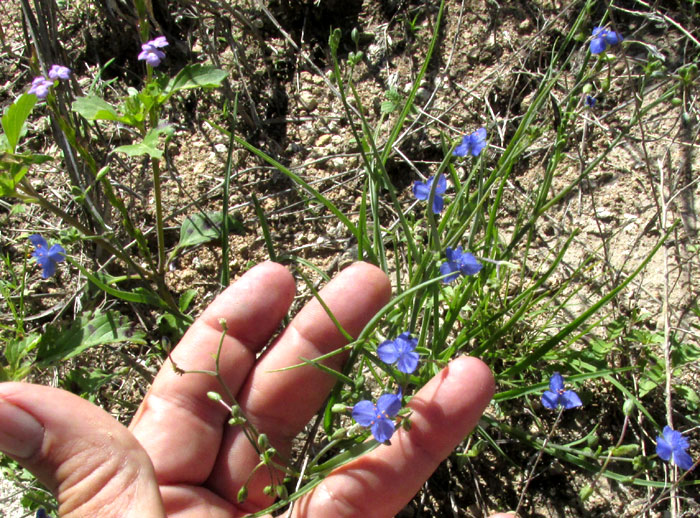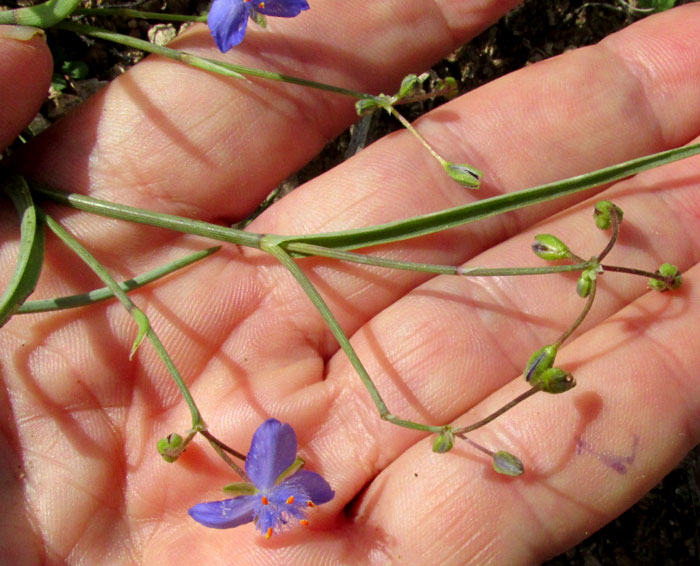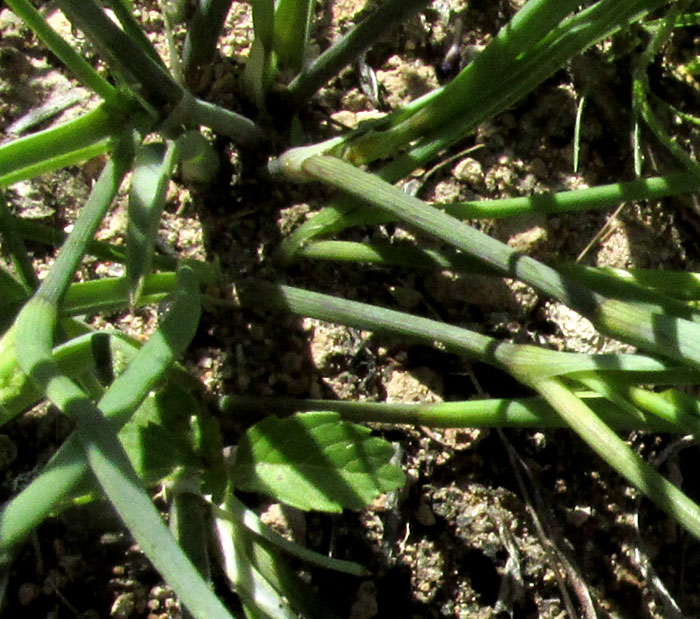Excerpts from Jim Conrad's
Naturalist Newsletter
entry dated September 5, 2022, issued from near Tequisquiapan, elevation about 1,900m (6200 ft), N20.565°, W99.890°, Querétaro state, MÉXICO
GIBASIS VENUSTULA

On a grossly overgrazed, firewood-gathered, generally abused hillside, in a large area where soil has eroded away leaving bare bedrock, at the edge of a bare area in very thin dirt, the above wildflower with its small, intensely sky-blue blossoms looked healthy and with plenty of flower buds ready to open. The flowers were especially delicate looking:

Six stamens and three petals, along with the plant's very slender, grassblade-like leaves, indicate a monocot, one of the top-level subdivisions, or clades, of the larger clade comprising all flowering plants. About a quarter of all flowering plants are monocots, so in terms of identifying our pretty plant, we've already eliminated most possible flowering-plant identities. In the above photo, it's interesting that the top-left flower is missing its yellow anthers, while its neighbors has them.

From the side, the flower's most striking feature is the stamens' blue-hairy filaments.
When people familiar with wildflowers, particularly northerners, see such flowers on such a plant, they're likely to think "spiderflower," genus Tradescantia of the Spiderwort Family, the Commelinaceae. That's what I thought, too, but species in the genus Tradescantia produce immediately below their rather compact flower clusters two large, conspicuous, leaf-like bracts, as displayed by the Zigzag Spiderwort we've seen in Mississippi. Below, though our plant's flowers are very similar to the Zigzag Spiderwort's, its flower clusters totally lack below them anything like two large, leaf-like bracts:

And here's what our plant's basal stems look like (note their silvery sheen, or glaucescence):

In this part of the world, if you find a member of the Spiderwort Family whose flowers' same-sized petals do not unite at their bases to form tubes, the flowers bear six fertile stamens all of equal lengths, and there's no hint of leaf-like bracts immediately below the diffuse groupings of flowers, you have the genus Gibasis. The genus Gibasis contains only about 11 species, with the center of species diversity in Mexico. In our semiarid, upland part of central Mexico known as the Bajío, six species have been documented.
In our area, if your Gibasis produces blue flowers with leaves not wider than 6mm (less than ¼ inch) and the whole plant has a silvery sheen to it, you have GIBASIS VENUSTULA. Three subspecies have been recognized for the species, and ours is subspecies venustula.
Gibasis venustula is endemic only to northern and central Mexico, and bears no English name, or even a Spanish one that I can find. Apparently if you're paying enough attention to notice that this isn't your usual spiderwort, you're the type who uses binomials. The name Gibasis, by the way, is based on the Latin gibbus, meaning swollen base.
Other than technical information such as its leaf width and such, and its appearance in various lists, I find nothing on the Internet about this plant. It's almost the same with the entire genus Gibasis. Sometimes local folks grow certain Gibasis species in pots, thinking their tiny, diffuse flowers are pretty.
Otherwise, with this plant you just have a little part of Nature helping along a few pollinators, keeping a little soil from eroding, giving itself up to an occasional herbivore, steadily dumping a little precious oxygen into the air, and providing a welcome pleasure for any human simply appreciating its presence.